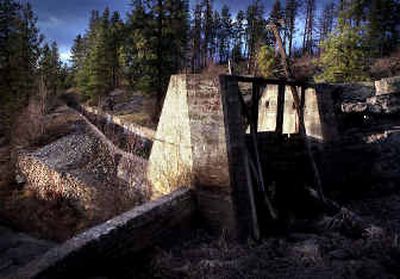Head gate restored

After more than three years of work by local history enthusiasts, the refurbished head gate of the Corbin Ditch made its official debut last week in Post Falls.
“Water is the story of the Valley,” said Jayne Singleton, director of the Spokane Valley Heritage Museum. “D.C. Corbin stood right here and said ‘let it flow,’ and it went right into Otis Orchards.”
Singleton joined more than 50 others at the dedication ceremony May 19 in Post Falls’ Falls Park where the restored head gate sits in an empty channel off the Spokane River.
Speakers touted the contribution to agriculture and the settlement of the Spokane Valley attributed to the otherwise unassuming tower of concrete and wood.
The gentle slope between Post Falls and Spokane Valley made ideal conditions to introduce canal irrigation at the turn of the century. That water, Singleton and others said, provided a catalyst for the agriculture that became a staple of the area’s early economy.
“It went over into Spokane and helped be an inducement for settlement,” said Kim Brown of the Post Falls Historical Society. “It kind of shows that our natural resources really are shared between state lines.”
In 1899, Daniel Chase Corbin and other investors saw the potential to profit from the water rights and agricultural potential of the Valley and formed the Spokane Valley Irrigation Co. Over the next decade, it developed the 34-mile Corbin Ditch, formally known as the Spokane Valley Land and Water Company Canal, and more than 54 miles of lateral ditches that brought water to thousands of acres of orchards and farms. After the wood-lined canals and head gate were completed, up to 200 cubic feet of water per second rushed through the gate and out into Spokane Valley under an agreement with Washington Water Power Co., now Avista Corp. Land prices rose, the population grew, and by the 1920s, “apple orchards sprang up everywhere,” Singleton said.
Water pumped from wells replaced irrigation from canals and area lakes in the 1960s, and sections of Corbin’s irrigation enterprise fell into disrepair.
After earlier efforts to preserve parts of the Corbin Ditch, the city of Post Falls, the Falls Park Committee, the Post Falls Historical Society and the Post Falls Lions Club began restoring the head gate in 2001. A Coeur d’Alene engineering firm drew up blueprints to help volunteers disassemble and catalog the gate’s nearly century-old parts.
Area property owners and companies donated services and material, and the Lions logged about 2,000 hours on the project over the next three years, finishing it in late 2004.
“One of the things they had trouble with was getting enough timber,” Brown said.
Two blocks of concrete, each roughly as tall as a two-story house, sit against the banks of the canal that was first used to power lumber and flour mills in the late 1800s. Between them, foot-wide timbers make up the newly restored gate. On top, walnut-sized bolts hold together a series of metal gears once used to lift it.
The sheer size of the parts made many of the volunteers wonder how the original gate was constructed and put into place without a crane or other modern tools.
“That was a big job for someone to do in 1900,” said Chuck King of the Valley museum.
After the dedication, he and Singleton salvaged some of the wood from the original head gate to display at the Spokane Valley Heritage Museum. The museum provided pictures of early Spokane Valley irrigation for the Post Falls exhibit.
“The thing I enjoy is that it’s a cooperative effort across two states,” Brown said.